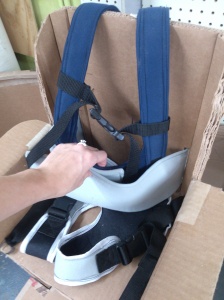On September 9th, I had the opportunity to shadow PT on two physical therapy visits with two different boys. These were my observations:
Child A – 9 months old; low muscle tone
PT has been working with Child A for the past few months. He was born with extremely low tone and when visits began three months ago, he was unable to lift his head, hold himself up, or hold a toy on his own. His only possible position was lying flat on his back with arms laid flat out on either side of him due to his inability to lift his arms upward. A good tactic to help him was ‘side-lying’, which positioned him on his side. It forced his legs together and his arms were in a better position in front of him.
Positioning of the child’s toys are important as well. For example, placing a toy forward in front of the child’s head will make him move his head forward, strengthening the neck muscles. At first, on his stomach, Child A could not pick his head up. It would fall down and he would get frustrated; slowly over time, he had gained the strength to lift it up.
PT uses toys to motivate Child A to reach forward, especially ones that are colorful and noisy to grab his attention- the toys or objects that are used as motivation make all the difference. She helps to hold him up a little bit but tries to get him to do it mostly on his own. One of the issues associated with his low muscle tone is that when he loses his balance and falls over, he makes no attempt to lift himself back up. Also, when he is held up in a standing position his legs collapse. There is no attempt at all to stand or keep them straight.
One product that PT uses with children with low muscle tone is called a gertie ball, which comes in sizes of 9″ or less. It is a ball that comes in different textured surfaces and you are able to blow it up as firm or as loose as you like, which makes it easier to grab and adjust. The child is placed on top of the ball in a sitting position which enhances his posture and gives him the opportunity to bear some weight on his feet. The 90 degree sitting position is really important for them to learn to do on their own- it is great for leg strength, waist strength, and neck/head strength.
Child A can go from his back to his side, but once he is on his side, he lacks arm and shoulder strength to lift himself up on to his stomach. Also, Child A struggles to lift his head so with every turn his head shakes a little, representing how unstable the movement is.
Child B – 2 years old; high muscle tone
PT has been working with Child B for the past few months. He can only stand if he is held since he struggles to stay upright, so she is working with him on lifting off the ground to get into a standing position. His high muscle tone causes him to keep his hands fisted and all of his ligaments brought in close to his body. Instead of crawling, he scoots around with his right leg in front of him and his left leg behind him, using his right leg to pull his entire body forward like this:
 To help him try to walk in the upright position, PT aids Child B in using a toy with a handle and wheels that he can use to support his weight. Even with the help, he is very wobbly when using the toy for support. He has problems with motor planning and has only figured out how to sit up 2 months ago with the help of physical therapy. Up until this point he can only sit up using the right side of his body; he still struggles to use his left side as support.
To help him try to walk in the upright position, PT aids Child B in using a toy with a handle and wheels that he can use to support his weight. Even with the help, he is very wobbly when using the toy for support. He has problems with motor planning and has only figured out how to sit up 2 months ago with the help of physical therapy. Up until this point he can only sit up using the right side of his body; he still struggles to use his left side as support.
Child B is gaining strength in his leg muscles and learning how to move from sitting to a standing position. PT is hopeful that he will eventually be able to walk on his own in a couple of years with continued therapy. Another method she uses to help him stand is supporting him with her arms and leaning him up against a wall cushioned with gym mats to help him gain balance. It is easier for him to stand when he is distracted by visual cues, such as a video on an iPad that is held up in front of him. He is not thinking about what he is doing at that point, but as soon as the video ends and he is no longer distracted, he ends up falling instantly.




